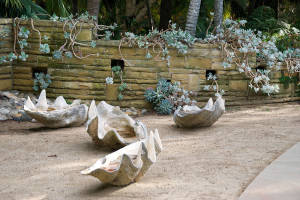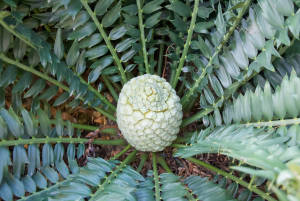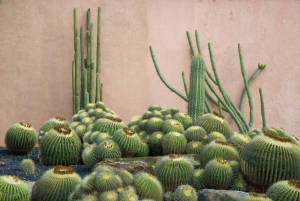
Discovering The Majesty of Lotusland
Long revered by visitors as one of the most incredible gardens in Southern California (and maybe even the world,) Lotusland sits on 37-acres of gorgeous, plant-filled property in Santa Barbara– about an hour’s drive along the coast from the bustling metropolis of L.A.
Lotusland is a feast for the eyes and a delight to the senses, a massive garden oasis full of tropical and subtropical plants from all over the world– including rare cycads, cacti, palms, waterlilies, aloes, euphorbias, and of course: the iconic Lotus, from which the garden draws its name. The estate at Lotusland, which Travel & Leisure magazine calls “one of the nation’s most beautiful gardens”, is home to a series of equally amazing themed gardens– among them a Japanese garden, a butterfly garden, a theatre garden, and a prodigious cactus garden– each of which is filled with such texture and variety of botany that even a seasoned plant connoisseur would be confounded at their beauty. Lotusland is a garden-lover’s paradise, and has come to be known as one of the most unique gardens in the world.
Lotusland’s charm has to do, in part, with the garden’s history. Polish Opera Singer Madame Ganna Walska, a renowned socialite who was born Hanna Puacz in 1887, purchased what would become the Lotusland estate in 1941 and spent the next 43 years of her life designing display gardens with exotic plants. She complimented mediterranean-style architecture from the 1920’s with striking masses of mature cactus specimens on the estate facade. Walska also experimented freely with bold forms and unusual color combinations, contrasting serene, traditional vistas with notably theatrical displays. When Walska died in 1984, her labyrinth of adventures was maintained, and Lotusland became a nonprofit botanical garden that opened to the public in 1993.
“Rare species of cycads that are now protected by international treaties were collected from all corners of the globe to create the stunning cycad garden,” Bob Craig told the GC Staff during a private walk through the garden last winter. (Madame Walska’s final gift to society was the striking collection that would become the Cycad garden, some of whose specimens are so rare that they are now hand-pollinated as part of conservation efforts made by members of Lotusland’s gardening staff. Three rare specimens known as Encephalartos woodii cycads, or “The Three Bachelors”, are rare South African varieties that Walska purchased from a supplier who got them directly from the Durban Botanic Garden. This was prior to the implementation of preservation treaties like CITES, which has since embargoed the import of such rare and threatened species.)
Many people come to Lotusland not knowing what to expect, but all of them leave spouting effusive praise. As exemplary stewards of the environment, the garden staff has adopted pesticide-free and sustainable techniques, using compost and mulch obtained from organic sources. Staff gardeners release beneficial insects fostered in on-site insectaries to devour harmful pests. Weeds, meanwhile, are pulled manually.
Lotusland encourages environmental stewardship through classes, seminars, and workshops as well as seminars, outreach, and education programs for local schools.
Many of the people who work at Lotusland go on to prosper at other very famous gardens, as Lotusland offers an immersive program that brings would-be gardeners in for two months to live and work (while getting paid. People have been known to make pilgrimages in order to be a part of this unique opportunity.) Lotusland also offers a great intern program, school programs, and has about 200 regular volunteers.In the course of our tour, the team gleaned several anecdotes from Craig and the numerous literary resources he lavished unto us upon our meeting. (“Did you know that lotus flower ‘heats up’ during sex?” reads one such pamphlet, which goes on to explain that the lotus family is one of the earliest groups of flowering plants on Earth, and that the flower, which has long been revered as a symbol of purity and spiritual transcendence by Hindus and Buddhists, can grow to be up to a foot in diameter.)
In addition to its seemingly-insurmountable beauty, Lotusland also hosts a popular series of events, like the annual Lotusfest! Celebration, in which lotuses are put on display in the the pond in the Japanese garden, and beautifully-conceived fundraisers like Lotusland Celebrates: Passage to India, an event in which the colors, textures, and sounds of India were woven into the beauty of Lotusland’s tranquil gardens.
A gorgeous flower-petal mosaic was laid out to mark the beginning of the pathway to this particular party, which is illustrative of the majesty that the garden’s programming typically bestows. Guests enjoyed everything from kirtan chanting and singing bowl vibration to a flash mob performance from 50 fire dancers surrounded by lit candles floating in the pond. The aloe garden was filled with temple incense and the bromeliad garden was transformed into a “Bodhi Tree” strung with over 1000 colorful ribbons tied with small scrolls that each contained a quote or other piece of wisdom. The elegant dinner on the great lawn was finished with a serving of chai tea, just as the sun began to set on the gardens. And that was just last year’s event.
For more information on Lotusland or to plan your visit, see the garden’s website.
Ganna Walska Lotusland Foundation
695 Ashley Road
Santa Barbara, California 93108












































